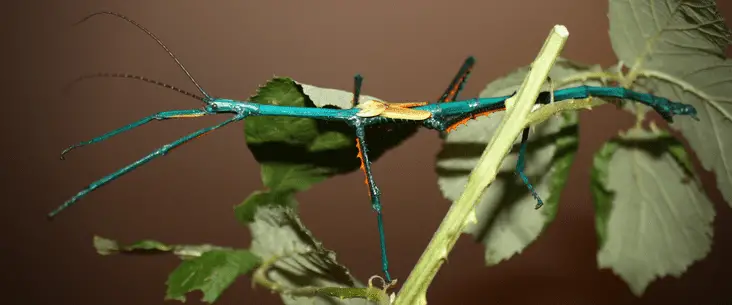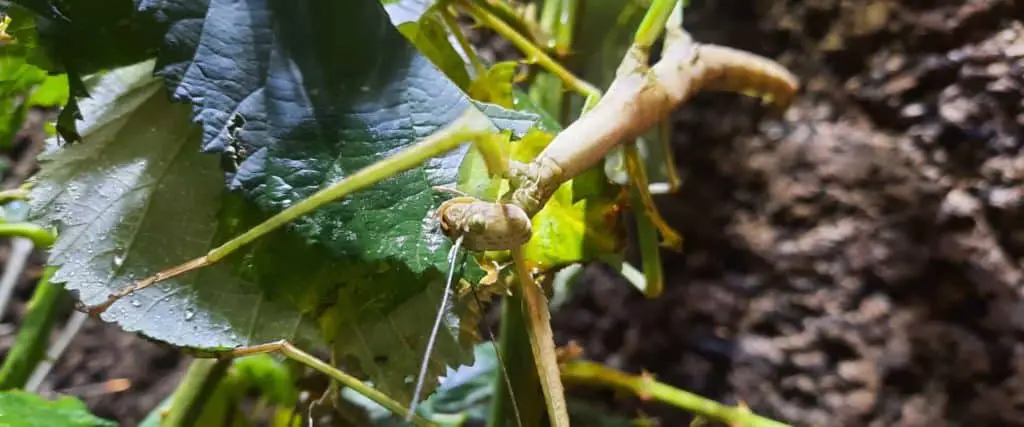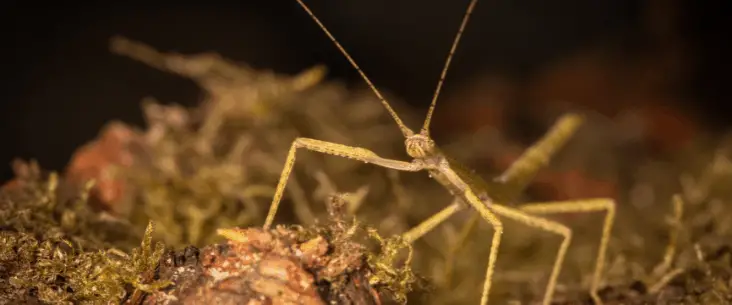There are more than 3000 species of phasmids (stick insects and leaf insects) in the world and regularly new species are discovered. Only 10%, around 300 species, are reared in captivity as pets. However, between those species in the pet industry, there are some quite unique and big specimens available. In this article, we will look at 5 (very) large stick insects that are regularly available for you to keep as pets.
We will look at these 5 big stick insect species:
- Giant Spiny Stick Insects (Extatosoma tiaratum) — PSG 9
- Giant Leaf Insect (Phyllium giganteum) — PSG 72
- Metallic Stick Insect (Archrioptera manga) — PSG 327
- Giant Walking Stick (Pharnacia ponderosa) — PSG 284
- Jungle Nymph (Heteropteryx dilatata) — PSG 18
Besides the scientific names, I also mention the PSG numbers to make sure there is no misunderstanding between species. Many species switch scientific names due to new insights in genetic relations, and many species don’t have trivial names.
We chose these 5 species not only because of their size but also because they are readily available at different (online) breeders and exotic pet expos. We start the list with one of the most popular stick insects in the pet industry: The giant spiny stick insect.
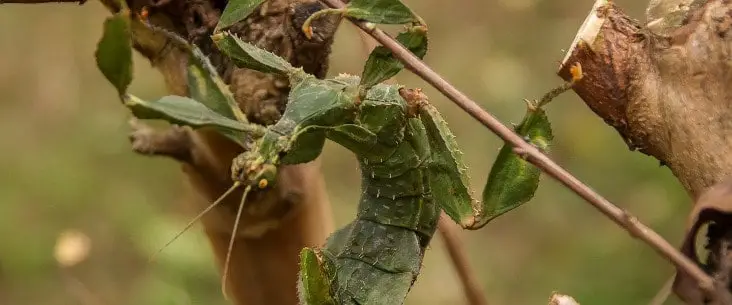
Giant Spiny Stick Insect (Extatosoma tiaratum) — PSG 9
This beautiful species of stick insects is one of the most commonly kept as pets. If you like to have a large and bulky stick insect species, these are great to start with.
Females of this original Australian species can grow up to 16 cm (6.3″). The males are much smaller with a size of around 10 cm (4″). But is not only the size that is already quite impressive, it is also the bulkiness of the body. Females have a quite thick abdomen covered with thorny appendages. Males, on the contrary, are slim like a stick. Females have also quite a big head.
These species are very easy to keep and take care of. That’s why they are so popular to have. They are also good breeders and sustaining a colony of giant spiny stick insects is really interesting to do at home.
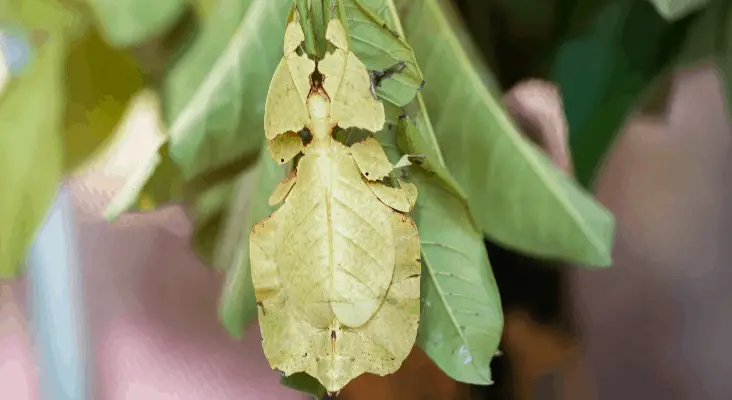
Giant Malaysian Leaf Insect (Phyllium giganteum) — PSG 72
Next on the list is a leaf insect instead of a stick insect. These beautiful creatures, also known as walking leaf, is shaped like a leaf and even mimics the nerves and colouration of real leaves.
The giant leaf insect, as the name suggests, is the biggest of them all reaching an adult size of around 10cm (4″). A beautiful species to keep as pets and is also regularly available in the pet industry.
However, these species are a bit more difficult to keep, have higher needs in their care and can sometimes be quite tricky to breed. When they were discovered in 1984 it was believed there were only females and that this species was only breeding asexual (also called parthenogenesis). It was only until 1994 that the first male of this species was discovered.
For this reason, you’ll see mostly females in captivity that breed without the presence of a male.
Another beautiful leaf insect species to keep is the Philippine Leaf Insect (Phyllium philippinicum — PSG 278).

Metallic Stick Insect (Achrioptera manga) — PSG 327
The most colourful large stick insect on this list is the metallic stick insect. Although not the official name and only used for commercial purposes in the pet industry, it is better known for its scientific name Achrioptera manga or PSG 327.
This beautiful blue metallic coloured species which originally comes from Madagascar (known to have more very strangely shaped and colourful animals) can reach a size up to 23 cm (9″).
Although the colours suggest that they are dangerous or venomous, they are completely harmless and very good stick insects to keep as pets. Be aware that they have quite some spiny appendages on their body and they can sting a little when you try to grab them.
This species is very easy to keep and take for and also quite easy to breed. So if you like to have a colourful and large stick insect species as a pet, this is the perfect stick insect species to go for.
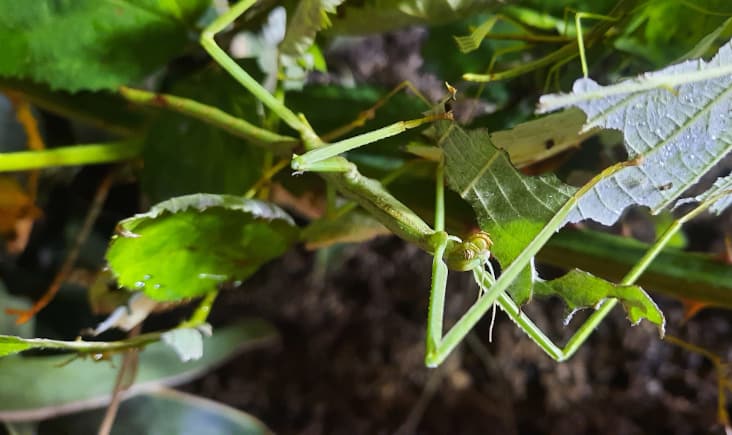
Giant Walking Stick (Pharnacia ponderosa) — PSG 284
These giants can reach a size of 22 cm (8.5″) in length and are also very sturdy animals (at least the females). Males are two-third of the size and are much thinner.
Actually, they don’t have a common name and is better known as Pharnacia ponderosa or PSG 284. Although it seems like they are becoming rearer in captivity, they are beautiful and easy stick insect species to keep and care for.
They are very easy and can easily be fed on bramble and oak, but also eat other types of leaves. They are especially easy to breed and you quickly have many of them.
When you try to let them walk on your hand, or try to move them outside the enclosure to clean, they can quite startle and become panicky. Still, I can recommend you this species when you are in search of a large stick insect species.
Related read: Pharnacia ponderosa: A Practical Care Guide
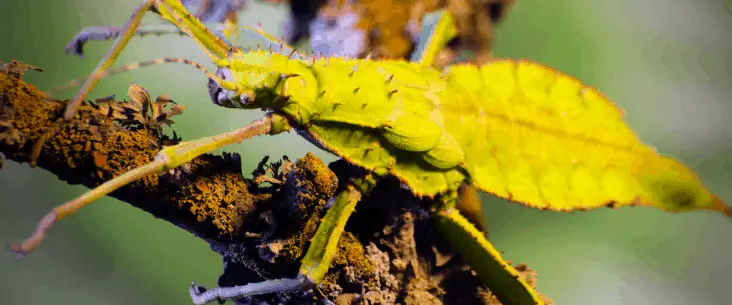
Jungle Nymph (Heteropteryx dilatata) — PSG 18
If you like big and sturdy, you should have a look at this one. The jungle nymph (a bit of a strange name?).
This real giant can reach a size of 15 cm (5.9″). And although that is not so impressive in itself, it is the big sturdy shape of the females with imposing thorns around its body and legs. If you have one on your hand you’ll see how spectacular stick insect species they are.
It is not only the size and bulkiness but also the colour of the females. They are beautiful bright lime/yellowish-green with darker red edges around her body.
Although they look impressive, they are harmless to keep. They are even quite easy to handle and very sturdy stick insects.
I have to mention that, even when do quite easily reproduce sexually, eggs can take a long time before they hatch. So you have to be very patient when you buy eggs. it will take around 11/12 months before the eggs hatch.
Related read: Jungle Nymph Stick Insect: A Practical Care Guide
Even bigger stick insect species
Now, we discussed 5 large species of stick insects here that are readily available, easy to care for and still have a considerable size. But, there are more stick insect species that are kept in the pet industry that are even bigger than the one we listed here. However, these species are more difficult to attain and in some cases are also more difficult to care for.
Still, here are some other species that are even bigger than some species we listed earlier:
| Species | PSG number | Size |
|---|---|---|
| Phobaeticus serratipes | PSG 25 | up to 25 cm (9.85″) |
| Tirachoidea jianfenglingensis | PSG 208 | up to 24 cm (9.45″) |
| Acrophylla titan | PSG 154 | up to 22 cm (8.66″) |
| Phryganistria heusii | PSG 277 | up to 21.5 cm (8.46″) |
| Achrioptera punctipes cliquennoisi | PSG 360 | up to 21 cm (8.27″) |
| Acrophylla wuelfingi | PSG 13 | up to 20 cm (7.88″) |
Challenges of keeping giant stick insects
Keeping bigger species of stick insects can pose some challenges to keep at home.
One of the major challenges is housing those large species. Although a stick insect species of 25 cm doesn’t sound very large, to house them you need to have an enclosure that is three times the body size in height. That means that you need an enclosure that has a minimum height of 75 cm (30″).
Why do they need this height, you ask? They need this height to have enough room to moult. Stick insect moult by hanging on a high place and slowly ‘drop’ themselves out of their old skin. This way gravity helps them removing their old skin. Without the proper height, you get misshaped body parts like bent legs. So it is crucial to keep them in an enclosure that has enough height.
The other challenge is that large stick insects eat a large amount of food. In this case: leaves. So you have to provide larger amounts of leaves to the animal. And it is difficult to buy fresh leaves, so you have to collect them yourself.
You should also be aware that larger enclosures are more difficult to keep at a stable temperature and humidity. So you’ll need more attention to that as well.
However, even with these challenges, with proper preparation, you can also easily keep larger species of stick insects. It is just that you are aware of them.
Fun facts about stick insect sizes
There is much more fun to tell about the sizes of stick insects. Check out these fun facts!
- The largest stick insect (Phryganistria chinensis) is only recently discovered in 2014 and has a length of 62.4 cm with the forelimbs stretched out. The body alone is already 38.2 cm long.
- The second largest stick insect species in the world, Phobaeticus chani, has a body length of 36 cm. And when the forelimbs are stretched out even a length of 56.7 cm. Only three specimen were found. It was only discovered in 2008 and was appropriately called the Chan’s Megastick.
- The third largest stick insect species in the world, Phryganistria heusii yentuensis, is only recently discovered (2014) in Vietman and measures a body length of 32 cm (with 54 cm when forelimbs are stretched out). Amazing that such large insects have been hidden for people for so long and are only be quite recently discovered.
- Stick insects hold the record for the longest insects in the world.
- Timema cristinae is one of the smallest stick insect species in the world, with only a size of around 2 cm.
- Female stick insects are generally larger than stick insect males (called sexual dimorphism). This way, when they are adults, you can easily tell which stick insects are males and which are females.
- Stick insect eggs are really tiny compared to the size of adults. Stick insects life cycle starts out with little nymphs hatching from the eggs. Egg sizes range from 2 mm up to 1.5 cm. Generally the larger the species, the larger the eggs.
Much more to learn!
There is much more to learn about stick insects. For example, do stick insects need a substrate? You can find more articles about stick insects with plenty of practical tips to better understand and enjoy the keeping of stick insects as a pet.
Share this page!

